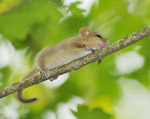New dormice strategy required
Strategies so far to reintroduce the common dormouse have had mixed success


Attempts to reintroduce the common dormouse to the wild have been going on for two decades, but a report commissioned by Natural England makes it clear that there's still plenty to do. Efforts began in earnest after a 1984 survey showed the snoozy rodents had vanished from seven counties.
However, The Dormouse Reintroduction Programme: A Review says that it may not be possible to restore dormouse populations to their former levels due to changes in land use and ‘the risks associated with climate change'.
The report suggests a shift in strategy from ‘expansion to consolidation', reintroducing the appealing little creatures in small groups to encourage sustainable ‘communities'. So far, however, this has not been widely achieved: of the nine woodlands where dormice were released more than 10 years ago, only two now have populations that are both stable within them and that have spread beyond their boundaries.
‘The proposals to create more targeted and linked projects would certainly be a positive step, especially with the limited resources that are at our disposal,' says Sue Tatman, Cheshire Wildlife Trust's conservation officer. ‘It's also vital that we keep the momentum for innovation.
* Subscribe to Country Life and save
* Follow Country Life on Twitter
Exquisite houses, the beauty of Nature, and how to get the most from your life, straight to your inbox.
Emma Hughes lives in London and has spent the past 15 years writing for publications including the Guardian, the Telegraph, the Evening Standard, Waitrose Food, British Vogue and Condé Nast Traveller. Currently Country Life's Acting Assistant Features Editor and its London Life restaurant columnist, if she isn't tapping away at a keyboard she's probably taking something out of the oven (or eating it).
